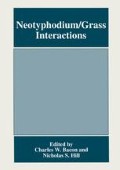Abstract
The agronomic and economic significance of Neotyphodium related toxicoses in South America is strongly associated with the relative importance and localization of the two main forage grasses that host Neotyphodium endophytes, namely tall fescue (Festuca arundinacea Schreb.) and perennial ryegrass (Lolium perenne L.).
Access this chapter
Tax calculation will be finalised at checkout
Purchases are for personal use only
Preview
Unable to display preview. Download preview PDF.
References
Altier, N. 1990. Estudios sobre Acremonium sp. en la festuca Estanzuela Tacuabé. Il Seminario Nacional de Campo Natural. 15–16 Noviembre de 1990, Tacuarembó, Uruguay. 377–382.
Bertoni, M.D, Cabral, D., Romero, N., and Dubcovsky, J. 1993. Endofitos fúngicos en especies sudameriacanas de Festuca (Poaceae). Bol. Soc. Argent. Bot. 29: 25–34.
Butendieck B., N., Romero Y., O., Hazard T., S., Mardones M., P., and Galdames G., R. 1994. Caida del consumo y producción de leche en vacas alimentadas con Lolium perenne infectada con Acremonium lolü. Agricoltura Técnica (Chile) 54: 1–6.
Cabral, D., Cafaro, M., and Saidman, B. 1996 a.. Caracterización isoenzimdtica de endofitos de gramineas tóxicas de Argentina. Il Congreso Latinoamericano de Micologia. La Habana, Cuba. (in press)
Cabral, D., Lugo, M., Cafaro, M., and White, J. 1996. b. Asociación de endofitos fúngicos en gramineas autóctonas argentinas. II Congreso Latinoamericano de Micologia. La Habana, Cuba. (in press)
Costa, M.C., De Battista, J.P., and Medus P.D. 1988. Comportamiento animal en pasturas de festuca (Festuca
arundinacea) con distintos niveles de infección de bongo endofitico. Rev. Arg. Prod. Animal 8:67–68.
Crawford, R.J., Jr., Forwood, J•R., Belyea, R.L. and Garner, G.B. 1989. Relationship between level of endophyte infection and cattle gains on tall fescue. J. Prod. Agric. 2: 147–151.
De Battista, J.P and Costa, M.C. 1994. Efecto del hongo endofitico Acremonium coenophialum sobre la habilidad reproductiva de la festuca alta. Rev. Arg. Prod. Animal. 14: 158–159.
De Battista, J.P., Costa, M.C., Hofer, C.C., Medus, P.D., and Pirovani A. 1991 a. Efecto del consumo de festuca infectada con Acremonium coenophialum. I. Perfomance animal en el periodo sobre festuca. Producción Animal. Inf. Técnica N23. INTA EEA C. del Uruguay. 76–80.
De Battista, J.P., Costa, M.C., Monje A.R., and Medus, P.D. 1991 b. Efecto del consumo de festuca infectada con Acremonium coenophialum. 2. Perfomance en el periodo post-festuca. Producción Animal. Inf. Técnica N23. INTA EEA C. del Uruguay. 81–84.
De Battista, J., Peretti, A., Carletti, S., Ramirez, A., Costa, M., and Schultz, I. 1995. Evolución de la incidencia de la infección de Acremonium coenophialum en la oferta de semilla de festuca alta en Argentina. Rev. Arg. Prod. Animal. 15: 300–302.
Duran M., H., Elizondo V., E., and Larrambebere D., F. 1990. Festucosis, descripción del problema y su existencia en Uruguay. II Seminario Nacional de Campo Natural. 15–16 Noviembre de 1990, Tacuarembó, Uruguay. 397–404.
Fernandez-Madrid, J.C. 1995. Diagnóstico de Acremonium Iola en pasturas de Lolium perenne L. implantadas en algunos partidos del sudeste bonaerense. Trabajo de intensificación. Facultad de Agronomia, Univ. de Buenos Aires. 61 p.
Galdames G., R. 1995. El hongo endófito de la festuca, Acremonium coenophialum Morgan-Jones & Gams y su incidencia en el Sur de Chile. Agricultura Técnica (Chile) 55: 67–70.
Latch, G.C.M. 1993. Physiological interactions of endophytic fungi and their hosts. Biotic stress tolerance imparted to grasses by endophytes. Agric., Ecosys. and Environ. 44: 143–156.
Lopez, T.A. 1979. Pie de festuca y su relación con otras enfermedades de origen fúngico. Boletín Técnico N2 78. INTA EEA Balcarce. 34 p.
Piontelli, E. and Toro, M. 1992. Endófitos fiíngicos en comunidades de pastos naturales: distribución en algunas especies de Lolium, Festuca, Bromus y Stipa. III Congreso Nacional de Fitopatologia. Valparaíso, Chile. p. 27.
Pomilio, A.B., Rofi, R.D., Gambino, M.P., Nazzini, C.A. and Debenedetti de Langenheim. A lethal pirinciple of Poa huecu (coiron balnco): a plant indigenous to Argentina. Toxicon 27: 1251–1262.
Prestidge, R.A., Pottinger, R.P., and Barker, G.M. 1982. An association of Lolium endophyte with ryegrass resistance to Argentine stern weevil. Proc. N.Z. Weed Pest Control Conf. 35: 119–122.
Rojas G.,C, Galdames G.,R., and Romero Y.,O. 1995. Efecto del hongo endófito de la festuca (Acremonium coenophialum Morgan-Jones & Gams) sobre la ganancia de peso en novillos a pastoreo. Agricultura Técnica (Chile) 55: 143–139.
Stuedemann, J.A. and Hoveland, C.S. 1988. Fescue endophyte: history and impact on animal agriculture. J. Prod. Agric. 1: 39–44.
Torres, M.S., Peretti, A., Colabelli, M.N., and Alonso, S. 1996. Presencia del hongo endófito Acremonium bola en semillas de Lolium perenne. 25avas. Jornadas Argentinas de Botanica, Mendoza, Argentina, 22–27 Noviembre 1996. in press.
White, J.F., Jr., Martin, T.I., and Cabral, D. 1996. Endophyte-host associations in grasses. XXII. Conidia formation by Acremonium endophytes on the phylloplanes of Agrostis hiemalis and Poa rigidifolia. Mycologia 88: 174–178.
Author information
Authors and Affiliations
Editor information
Editors and Affiliations
Rights and permissions
Copyright information
© 1997 Springer Science+Business Media New York
About this chapter
Cite this chapter
De Battista, J., Altier, N., Galdames, D.R., Dall’Agnol, M. (1997). Significance of Endophyte Toxicosis and Current Practices in Dealing with the Problem in South America. In: Bacon, C.W., Hill, N.S. (eds) Neotyphodium/Grass Interactions. Springer, Boston, MA. https://doi.org/10.1007/978-1-4899-0271-9_60
Download citation
DOI: https://doi.org/10.1007/978-1-4899-0271-9_60
Publisher Name: Springer, Boston, MA
Print ISBN: 978-1-4899-0273-3
Online ISBN: 978-1-4899-0271-9
eBook Packages: Springer Book Archive

